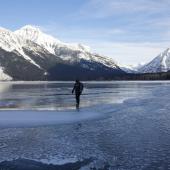Time Traveling Through Montana's Mesozoic Park
Most people travel through Montana viewing the mountains or the plains, the forests or the wheat fields, as each exists today, but a few of us travel in time. We time travelers are paleontologists and geologists who understand the meaning of the rocks and sediments that make up the modern-day countryside.
Recognizing rocks that represent sediments deposited in rivers, lakes, or oceans, allows us to imagine ourselves into the past, and visualize extinct habitats and ecosystems, each filled with exotic plants and animals. Unfortunately, the fossil record does not provide a complete history of life, but instead it gives us little snapshots that are recorded in geological units called formations. Here in Montana we have five primary geological formations that provide fossil remains from the age of the dinosaurs. We can imagine the dinosaurs and how they lived by examining their skeletons and other fossils, like nests, eggs, and footprints. Many of these types of fossils are on display in the museums scattered along Montana’s Dinosaur Trail.

The oldest dinosaur-bearing rock formation in Montana is called the Morrison Formation. It produces dinosaur remains from about 155 million years ago, or what geologists call the late Jurassic Period. During this period of time, Montana was flat. A warm, inland sea covered most of northern and eastern Montana. The land was covered with ferns, cycads, and coniferous trees. No flowering plants or hardwood trees had existed yet. Feeding in the lowlands near the seaway were the giant, long-necked sauropods like Diplodocus and Barosaurus. There were also other plant eaters like the plated Stegosaurus and the bipedal Camptosaurus. The primary meat-eater was the ferocious Allosaurus. Fossils of these Jurassic age dinosaurs can be seen in The Museum of the Rockies in Bozeman and the Great Plains Dinosaur Museum in Malta.
The next dinosaur snapshot is younger and takes us into the early Cretaceous Period. These sediments were deposited around 120 million years ago and contain fossils provided by the Cloverly Formation. Montana remained flat without mountains, while an inland sea continued to occupy the northern and eastern regions of the state. But, the animals had undergone a significant change. Most of the long-necked sauropods had gone extinct, and Stegosaurus had been replaced by an armored ankylosaur. The herbivorous Camptosaurus was replaced by a similar looking dinosaur called Tenontosaurus. The top predator of the early Cretaceous became Deinonychus, the dinosaur portrayed in the movie Jurassic Park as Velociraptor. While the dinosaurs underwent major changes, the most striking change occurred to the flora, or plant life. It was at this time when the flowering plants first arrived. The Museum of the Rockies holds a collection of fossils from this time period.
Rocks from the late Jurassic and early Cretaceous Periods are rare in Montana. They are found mostly around the uplifted mountain ranges. The late Cretaceous Period contains the best dinosaur fossils, as there are many places in eastern Montana where the rocks from this time are exposed at the surface of the ground.
About 100 million years ago, the inland sea that had extended into northern and eastern Montana from the north, expanded westward and southward to meet another inland sea that extended up from the Gulf of Mexico. When these two seas met, they divided North America into two landmasses. Named the Intercontinental Cretaceous Seaway, this body of water helped maintain a subtropical environment in Montana and Alberta from about 80 million years ago until around 65 million years ago. It was about this time when the Rocky Mountains began to uplift to the west and push the inland sea out of western Montana, limiting its extent in the eastern part of the state. With the Rockies to the west and an inland sea to the east, a broad coastal plain formed in much of the central and western part of eastern Montana. The landscape was flat and vegetated with plants similar to many of the plants now growing in Louisiana, like palms and cypress trees. There were no grasses and the open plains were abundant with ferns and bushes. Hardwood trees lined the rivers and the conifers intermingled. This broad, subtropical coastal plain is represented by several rock formations, each of which produce important dinosaur faunas.

The dinosaur site named Egg Mountain, located just west of Choteau, revealed the first evidence that dinosaurs cared for their young and lived in giant nesting grounds. It was in this area that the first dinosaur embryos were discovered, and evidence of giant herds of dinosaurs were found. The Two Medicine Formation has yielded the remains of dinosaurs such as Montana’s state fossil, the duck-bill Maiasaura, and the horned dinosaurs Einiosaurus and Achelousaurus, as well as the carnivorous Daspletosaurus, Troodon, and Bambiraptor. Dinosaur specimens from Egg Mountain and nearby areas can be seen at the Museum of the Rockies in Bozeman, The Old Trail Museum in Choteau, the Two Medicine Dinosaur Center in Bynum, and the Depot Museum in Rudyard.
The fossil remains from the Two Medicine Formation represent animals that lived near the Rocky Mountains around about 75 million years ago. At the same time there were other dinosaurs living closer to the seaway, and these dinosaurs are found in a rock unit called the Judith River Formation. Common to the Judith River Formation were dinosaurs such as the duck-bills Brachylophosaurus and Gryposaurus, the horned dinosaur Avaceratops, and meat-eaters such as Albertosaurus. These and other dinosaur remains from the Judith River Formation can be seen in the Depot Museum in Rudyard, the H. Earl Clack Memorial Museum in Havre, the Great Plains Dinosaur Museum and Phillips County Museum in Malta, the Blaine County Museum in Chinook, and the Upper Musselshell Museum in Harlowton.
From approximately 73 million years ago until about 69 million years ago, the inland sea expanded covering most of Montana east of the Rockies with an ocean. At this time the Bearpaw Formation was deposited, containing many marine creatures like Plesiosaurs and Mososaurs, some of which can be seen in the Museum of the Rockies, in Bozeman, and the Fort Peck Interpretive Center in Fort Peck.
Over a three-million year period, from 68 to 65 million years ago, the last Cretaceous sediments were deposited in Montana as the intercontinental seaway retreated. To the west these sediments are called the Saint Mary River Formation, and to the east the rocks are called the Hell Creek Formation. The Hell Creek Formation produces Montana’s most famous dinosaurs including Tyrannosaurus rex and Triceratops. Revealed here is also the period of time when dinosaurs went extinct. The last dinosaurs to exist in Montana are on display in The Fort Peck Interpretive Center and Museum in Fort Peck, the Garfield County Museum in Jordan, the Makoshika Dinosaur Museum and Makoshika State Park in Glendive, and the Museum of the Rockies in Bozeman.
By visiting the museums along Montana’s Dinosaur Trail, people are given the opportunity to travel in time through “Montana’s Mesozoic Park,” seeing some of the very best dinosaur remains found in the world. It’s a great way to see Montana, both in the present and the past.













Leave a Comment Here